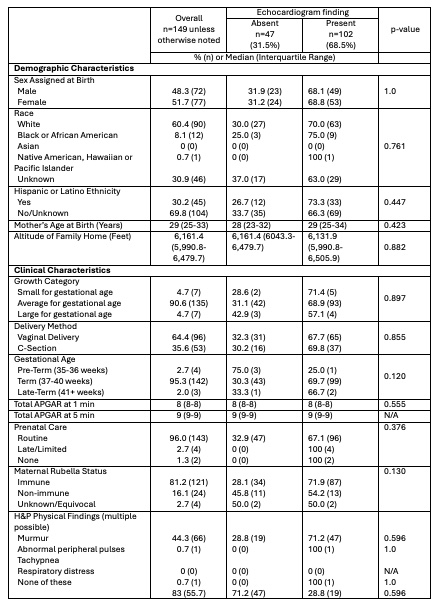Neonatal General 11
Session: Neonatal General 11
414 - Prevalence of Congenital Cardiac Disease Among Well Newborns Born at Moderate Altitude With Cardiac Murmurs
Monday, April 28, 2025
7:00am - 9:15am HST
Publication Number: 414.6217
Anna Lawrence, University of Colorado School of Medicine, Colorado Springs, CO, United States; Meenu Sharma, Children's Hospital Colorado, Colorado Springs, CO, United States; Sonja I. Ziniel, University of Colorado School of Medicine, Aurora, CO, United States; Allyn Kawalek, Children's Hospital Colorado, Colorado Springs, CO, United States; Elizabeth E. McKelvey, University of Colorado School of Medicine, Monument, CO, United States; Jeanne M. Richardson, Children's Hospital Colorado, Colorado Springs, CO, United States; Shannon M. Duvernell, Children's Hospital Colorado, Colorado Springs, CO, United States; Erin T. Lueth, Children's Hospital Colorado, LONE TREE, CO, United States; Peggy Guo, University of Colorado/Children's Hospital of Colorado, Colorado Springs, CO, United States; Hannah Neubauer, University of Colorado School of Medicine, Colorado Springs, CO, United States

Anna Lawrence, MD (she/her/hers)
Pediatric Hospitalist
University of Colorado School of Medicine
Colorado Springs, Colorado, United States
Presenting Author(s)
Background: Cardiac murmurs are common in healthy newborns, and echocardiogram is often used to help distinguish between benign and pathologic murmurs. PDA is a common cause of murmur in the immediate neonatal period. Limited evidence suggests that moderate altitude is associated with congenital heart disease (CHD), particularly with greater prevalence of patent ductus arteriosus (PDA) and pulmonary hypertension. Overall, literature on healthy newborns with murmurs born at moderate altitude is limited.
Objective: To understand the prevalence of congenital heart disease and clinical findings of well newborns born at moderate altitude who underwent echocardiogram due to presence of a murmur.
Design/Methods: We conducted a retrospective cohort study of newborns 35 weeks gestational age or greater born at two sites located at moderate altitude (~1900m) from 2020 to 2023 who underwent echocardiogram for presence of cardiac murmur. We excluded newborns with neonatal intensive care, known or suspected genetic/chromosomal abnormality, antibiotic administration, hypoxemia, or cardiac abnormality noted on fetal ultrasound. Data was analyzed via descriptive statistics using percentages for categorical and medians with interquartile ranges for continuous variables. Bivariate associations between presence of cardiac findings and patient characteristics were assessed using Fisher’s exact and non-parametric median tests.
Results: Of a total of 2,061 charts, 505 charts were manually reviewed to date with 149 healthy newborns meeting eligibility criteria. Approximately 95% were at term, 48% were male, and 96% had routine prenatal care (Table 1). Of the 149 newborns with murmur, 102 (69%) had cardiac findings on postnatal echocardiogram. PDA alone was the most prevalent finding (52%), followed by newborns with an atrial level shunt (23%, Figure 1). There were no clinical characteristics significantly associated with presence of abnormal echocardiogram findings (Table 1). Interestingly, term and late-term newborns with murmur were more likely to have findings on echocardiogram, though this was not statistically significant.
Conclusion(s): PDA was the most prevalent finding among newborns with murmur born at moderate altitude. No cyanotic congenital heart disease was identified in this population of infants. Further study is needed to better understand the significance of a cardiac murmur and the utility of echocardiogram in the healthy newborn population at altitude.
Table 1
 Demographic and Clinical Characteristics of Well Newborns with Murmurs and Bivariate Analyses with Presence of Echocardiogram Findings
Demographic and Clinical Characteristics of Well Newborns with Murmurs and Bivariate Analyses with Presence of Echocardiogram FindingsFigure 1
.jpg) Cardiac Findings on Echocardiogram Among Well Newborns with Murmurs
Cardiac Findings on Echocardiogram Among Well Newborns with Murmurs *Other abnormality refers to valvular or aortic abnormality

